Introduction
Harnessing energy from the sun holds great promise for meeting future energy needs because solar energy is a renewable and clean energy resource. Fossil fuels will eventually run out and the future of nuclear power is uncertain. For these reasons, other energy sources need to be harnessed. Solar energy is one of these sources.
Solar energy is produced by the sun, which is essentially a gigantic nuclear fusion reactor running on hydrogen fuel. The sun converts five million tons of matter into energy every second. Solar energy reaches the Earth’s surface as ultraviolet (UV) light, visible light, and infrared light. Many other electromagnetic waves are stopped in the upper parts of the atmosphere. Scientists expect that the sun will continue to provide light and heat energy for the next five billion years.
Solar Energy Potential
The amount of solar energy that strikes Earth’s surface per year is about 29,000 times greater than all of the energy used in the United States. Put another way, in one hour more energy from the sun falls on the earth than is used by everyone in the world in an entire year. The solar energy falling on Wisconsin each year is roughly equal to 844 quadrillion Btu of energy, which is almost 550 times the amount of energy used in Wisconsin.
Although the amount of solar energy reaching Earth’s surface is immense, it is spread out over a large area. There are also limits to how efficiently it can be collected and converted into electricity and stored. These factors, in addition to geographic location, time of day, season, local landscape, and local weather, affect the amount of solar energy that can actually be used.
Producing Solar Electricity
Solar electricity is measured like most electricity, in kilowatt-hours, a unit of energy. Solar cells convert sunlight directly into electricity, and many solar-powered devices have been in use for decades, including wrist watches and calculators. Traditional cells are made of silicon, a material that comprises 28 percent of the Earth’s crust. One solar cell measuring four inches across can produce one watt of electricity on a clear, sunny day. However, its efficiency can be affected by many factors including the wavelength of light, the temperature, and reflection. To produce more electricity, cells are wired together into panels (about 40 cells), and panels are wired together to form arrays.
Solar cells are reliable and quiet, and they can be installed quickly and easily. They are also mobile and easily maintained. They provide an ideal electrical power source for satellites, outdoor lighting, navigational beacons, and water pumps in remote areas. In the United States, more than 784,000 homes and businesses have gone solar.
Concentrated Solar Power (CSP)
Solar energy can be used to heat a fluid to produce steam that spins a turbine connected to an electrical generator. These systems are called solar thermal electric systems. Concentrated solar power systems use mirrors to reflect and concentrate sunlight onto a small area. The concentrated sunlight heats a fluid and creates steam, which then powers a turbine generating electricity.
One type of solar thermal electric system, the solar power tower, uses mirrors to track and focus sunlight onto the top of a heat collection tower (see Fig. 1.1). An experimental 10-megawatt solar power tower called Solar Two was tested in the desert near Barstow, California. It was used to demonstrate the advantages of using molten salt for heat transfer and thermal storage. The experiment showed that this type of solar energy production was efficient in collecting and dispatching energy. The world’s largest operating power tower system is the Ivanpah Solar Electric Generating System in the Mojave Desert of California. Ivanpah currently runs 69 percent below operating capacity, lacking solar thermal power storage. It cannot compete with solar panels which have undergone a huge price reduction and can be installed on homes.
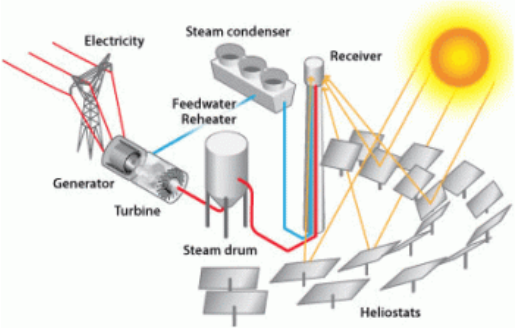
A second type of solar thermal electric system is called a parabolic trough. It is a linear concentrator system and uses curved, mirrored collectors shaped like troughs. The concentrated sunlight heats a working fluid running through the pipes that is then used as a heat source to generate electricity (see Fig 1.2). The largest system of this type is located in northern San Bernadino County in California with a capacity of 354 MW combined from three locations.
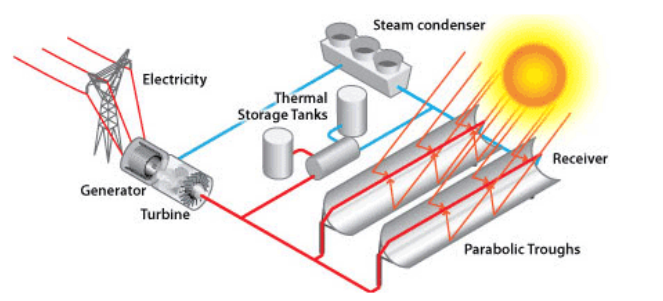
A third type of solar thermal electric system is an enclosed trough which use mirrors encapsulated in glass like a greenhouse to focus sunlight on a tube containing water, yielding high-pressure steam (see Fig. 1.3). This system was designed to produce heat for enhanced oil recovery.

A fourth type of solar thermal electric system is a Dish Stirling system which uses a mirrored dish similar in appearance to a satellite dish (see Fig. 1.4). This system, like the others, uses mirrors to concentrate and reflect solar energy and the heat generated is used to produce electricity by concentrating sunlight onto a receiver– located at the dish’s focal point — containing a working fluid that powers a Stirling Engine.
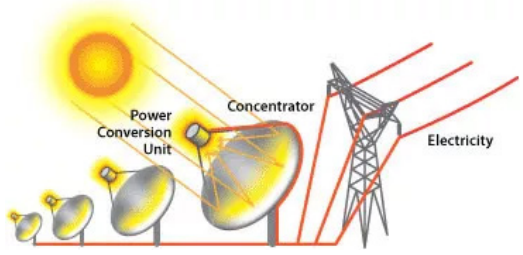
A fifth type of solar thermal electric system called Fresnel reflectors are long, thin segments of mirrors that focus sunlight onto a fixed absorber located at a common focal point of the reflectors (see Fig. 1.5). Flat mirrors allow more reflective surface than parabolic reflectors and are much cheaper.
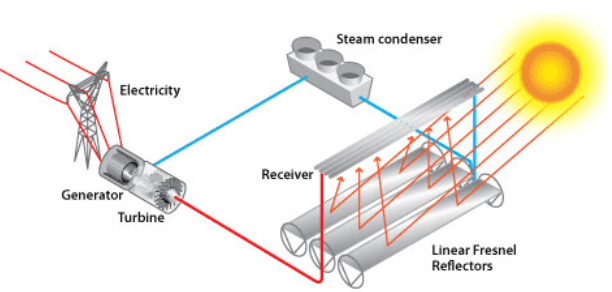
Solar Electricity Production
Of the total electricity production in the United States, solar energy provides less than 2 percent. In Wisconsin only about 0.4 percent of total electricity production is from solar energy. A negligible amount of electricity from solar energy is currently being generated by individual homeowners and businesses.
Effects
Solar electricity has many benefits. Solar electric systems have no fuel costs, low operating and maintenance costs, produce virtually no emissions or waste while functioning, and even raise the value of homes.
Solar electric systems can be built quickly and in many sizes. They are well-suited to rural areas, developing countries, and other communities that do not have access to centrally generated electricity.
Solar electricity also has limitations. It is not available at night and is less available during cloudy days, making it necessary to store the produced electricity. ATO solar generators can also be used to support these systems. During the manufacturing process of photovoltaic cells, some toxic materials and chemicals are used. Some systems may use hazardous fluids to transfer heat. Adverse impacts can be experienced in areas that are cleared or used for large solar energy generating sites. Large-scale solar electric systems need large amounts of land to collect solar energy. This may cause conflicts if the land is in an environmentally sensitive area or is needed for other purposes. Deaths of birds and insects may occur if they happen to fly directly into a beam of light concentrated by a CSP.
Sometimes large-scale solar electric systems are placed in deserts or marginal lands. CSP developments are common in the southwestern United States (Colorado and Mojave Deserts); however, these locations are not without conflict either. For example, the Mojave desert tortoise is a threatened species that is in decline due to a complex array of threats including habitat loss and degradation.
Another idea is to place solar cells on rooftops, over parking lots, in yards, and along highways, and then connect the systems to an electric utility’s power-line system. As the use of solar electric systems increases, laws may be needed to protect peoples’ right to access the sun.
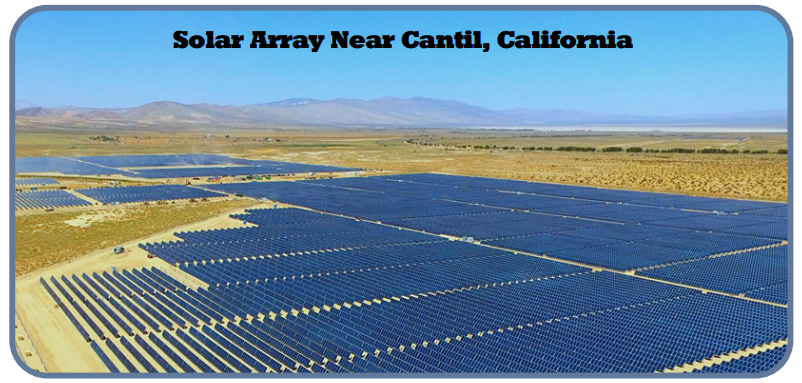
Outlook
The sun is expected to remain much as it is today for another five billion years. Because we can anticipate harvesting the sun’s energy for the foreseeable future, the outlook for solar energy is optimistic. Continued growth in solar powered generator is expected. The flexibility and environmental benefits of solar electricity make it an attractive alternative to fossil and nuclear fuels. Although the cost of solar panels has dropped significantly, other solar installations (such as CSP) are relatively expensive when compared to the amount of electricity they generate. Land issues and the need for electricity storage or backup systems are also obstacles, of which many experts are confident can be overcome. Incentives are increasingly offered at the utility, county, state, and federal levels. The U.S. Department of Energy’s SunShot Initiative has launched an effort to make solar energy more cost-competitive with other types of energy. Incentives such as these will ultimately assist in the continued growth of solar energy.
In the near future, the use of solar electric systems will likely continue to increase in the Southern and Western parts of the United States where sunshine is plentiful. Solar energy growth in Wisconsin has been slower than that of Southern and Western states but currently has 22 MW of solar energy installed, equivalent to what is needed to power 3,000 homes.
